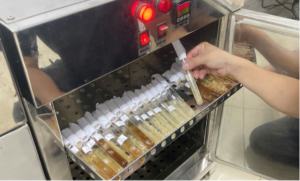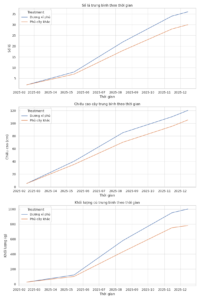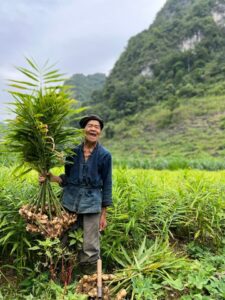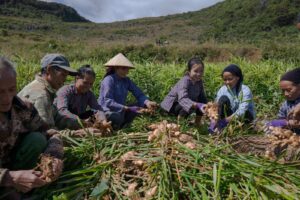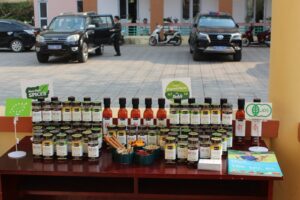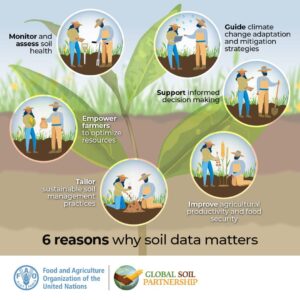After 12 years of closely monitoring the organic ginger growing regions developed by DACE in Luc Khu – a harsh land without water, where only mist, soil, rocks, and indigenous knowledge exist – we noticed that the ginger in this area has been growing increasingly well and achieving higher yields year after year. So what is the secret behind this 300-hectare sustainable organic ginger production region?
Among many farming techniques like composted organic fertilizers and different mulching materials, we discovered a biological secret – the ancient fern. During the production process, we realized that the ginger beds covered with fern leaves or intercropped with ferns grew better than those mulched with other plant materials. This inspired DACE’s technical team to conduct a unique research study in 2024. The result: mulching with fern leaves increased ginger yield by 27.6%, significantly enhanced plant vigor, and reduced heavy metal absorption.
Why Ferns?
Ferns – ancient plants that have existed for over 350 million years – are not only effective moisture-retaining ground covers, but also home to unique microbial communities. Research revealed that beneficial bacteria living on fern leaves such as *Bacillus endophyticus*, *Pseudomonas fluorescens*, and *Burkholderia phytofirmans* help to:
– Activate plant growth hormones for ginger
– Enhance nutrient uptake and antioxidant capacity
– Reduce absorption of heavy metals like Arsenic (As), Cadmium (Cd), and Lead (Pb)
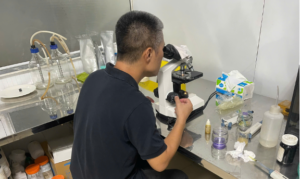
How Do Ferns ‘Activate’ Ginger?
| Impact | Description | Scientific Evidence |
| Optimized Soil Microclimate | Fern leaves are porous, retain moisture, and reduce soil surface temperature → more stable, stress-free root environment. | Our trials: ginger plants were 15 cm taller. |
| Slow, Non-toxic Decomposition | Fern lignin and polyphenols break down gradually, releasing nutrients slowly without producing allelopathic toxins. | Research on pteridophyte mulching. |
| Ancient Microbial Communities | Ferns (Pteridophyta) have evolved with PGP bacteria (Bacillus, Pseudomonas) and AM fungi that produce phytohormones and enhance N-P-K uptake. | Overview of PGPB for heavy metal-stressed crops. |
| Heavy Metal Immobilization (Download samples test restult) |
Ferns like *Pteris vittata* hyperaccumulate As, Cd, Zn. Their associated microbes convert metals to non-toxic forms. | Studies on ferns + heavy metals (pubmed, wired.com). |
| Chain Effect on Ginger | Cleaner soil → less root respiration stress; HM-resistant microbes trigger antioxidant enzymes. | Similar microbiome models reduce heavy metals in ginger (pmc.ncbi.nlm.nih.gov, pubs.acs.org). |
Key Results from DACE’s 3 Test Models
| Indicator (12/2025) | Fern Mulch | Other Mulch | Difference |
| Yield (tons/ha) | 25.0 | 19.6 | + 27.6% |
| Leaves per clump (avg.) | 36 | 30 | + 6 leaves |
| Plant height (avg., cm) | 120 | 105 | + 15 cm |
| Rhizome weight per clump (g) | 1000 | 780 | + 220 g |
Yield reached 25 tons/ha, compared to 19.6 tons/ha in beds mulched with other plant materials.
Figure 1. Growth chart of ginger under fern mulch vs. control.
A Sustainable Approach Through Natural Microbes
Without chemical fertilizers or pesticides, the model of “Ferns – Ginger – Ancient Microbiome” proves that clean agriculture can be built on biological intelligence. DACE will continue expanding this model and developing a microbial bioproduct from fern-associated bacteria, paving the way for a truly green agricultural future.
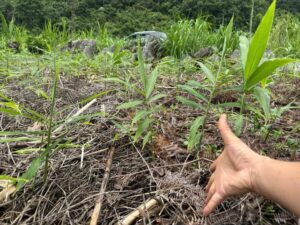
“DACE Organic Ginger is not only clean – it is the product of a vibrant, natural ecosystem, where even each mulch leaf carries the vitality of hundreds of millions of years.”
Want to learn more about our organic ginger growing methods or explore collaboration opportunities?
Visit us at: www.dace.vn or our DACE Organic fanpage.
